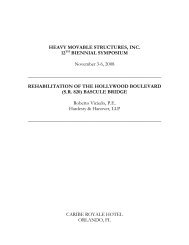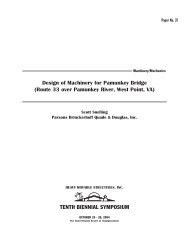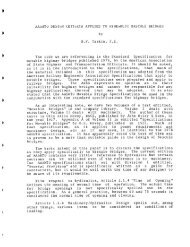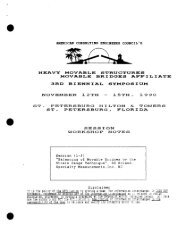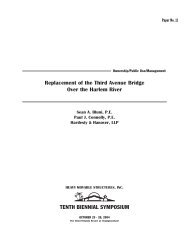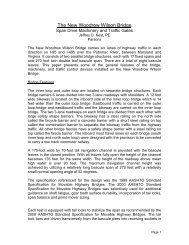Fatigue of Counterweight Sheave Trunnions - Heavy Movable ...
Fatigue of Counterweight Sheave Trunnions - Heavy Movable ...
Fatigue of Counterweight Sheave Trunnions - Heavy Movable ...
Create successful ePaper yourself
Turn your PDF publications into a flip-book with our unique Google optimized e-Paper software.
Trunnion Repair and Strengthening Options<br />
<strong>Fatigue</strong> Life Extension <strong>of</strong> Main <strong>Counterweight</strong> <strong>Sheave</strong> <strong>Trunnions</strong><br />
Trunnion repair or strengthening provides a proactive solution for safe bridge operation because<br />
emergency repairs, and the associated traffic closures and/or restrictions to marine traffic, would be<br />
avoided.<br />
Performing work to repair or strengthen the trunnions before cracks form is beneficial in that work can be<br />
carried out without the time pressures and increased costs associated with emergency work. These repairs<br />
can also be performed to remove cracks if these cracks are detected early enough.<br />
Several methods to improve endurance; shot peening, pneumatic peening, ultrasonic impact treatment,<br />
machining the transition fillet, and grindinglpolishing are analyzed. These methods are considered repairs<br />
in that they extend service life without adding load carrying capacity or a redundant load path.<br />
The use <strong>of</strong> a post tension assembly is the only strengthening method analyzed.<br />
Shot Peening<br />
Shot peening is a cold working process in which the transition fillet would be bombarded with small<br />
spherical media (cast steel shot). Each piece <strong>of</strong> shot striking the base material acts as a tiny peening<br />
hammer. The peening action induces compressive stresses at the surface and also acts to cold work the<br />
steel. Benefits obtained by shot peening are the result <strong>of</strong> the effect <strong>of</strong> the compressive stress and cold<br />
working induced. Shot peening can produce the following benefits:<br />
<strong>Fatigue</strong> cracks will not initiate in a compressively stressed zone. Peening induces compressive stress<br />
at the part surface, where most fatigue and stress corrosion failures originate.<br />
<strong>Fatigue</strong> test data on smooth and notched shafts shows that shot peening produces endurance in the<br />
notched shaft equal to a polished straight shaft. This results from the induced compressive stress at<br />
the surface that <strong>of</strong>fsets the load tensile stress.<br />
Crack arrest by compressive self-stress can result. A crack initiated by a tensile stress magnified by a<br />
stress concentration can be arrested because the induced compressive stress is normally highest just<br />
below the surface, away from the maximum stress caused by the stress concentration.<br />
Peening can eliminate stress raisers resulting from manufacturing processes such as grinding,<br />
machining and welding.<br />
Benefits from cold working include work hardening, intergranular corrosion resistance, surface<br />
texturing and closing <strong>of</strong> porosity.<br />
Shot peening imparts a fairly uniform residual compressive stress (0,) to a depth (d) from the surface.<br />
The maximum residual compressive stress (o,,,,) occurs slightly below the surface. The magnitude <strong>of</strong><br />
o,,, is related to the hardness <strong>of</strong> the material and thus the yield strength (F,) <strong>of</strong> the material. Typically,<br />
the minimum value <strong>of</strong> o,,,, is 0.5F, and the residual compressive stress at the surface is 0.4FY. Forgings<br />
used for trunnions typically have yield strengths between 30 ksi and 50 ksi. This is at the low end <strong>of</strong> the<br />
hardness scale for steels that are peened. A 0.020" depth (d) for the induced stress can be achieved for<br />
steels in this hardness range.<br />
Shot peening the transition fillet should return the endurancc <strong>of</strong> the trunnion to as-built levels if cracks<br />
and surface irregularities are removed prior to peening.<br />
HEAVY MOVABLE STRUCTURES, INC.<br />
gth Biennial <strong>Movable</strong> Bridge Symposium





